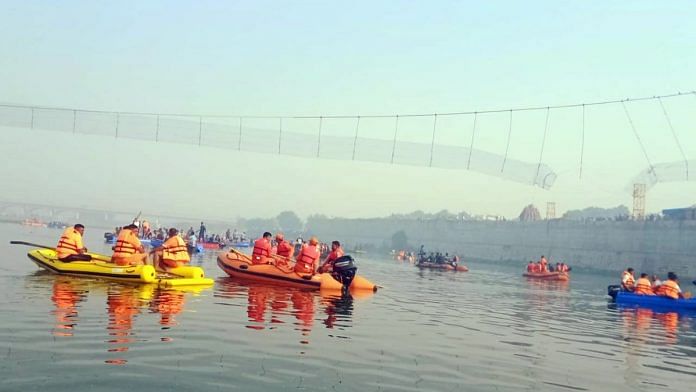The Gujarat model’ is a narrative that the Bharatiya Janata Party has consistently sold across the country in every election, talking up the state’s wide highways and high-speed trains.
Last week’s Morbi bridge collapse punched a big hole in this narrative at a time when the party is trying to sell the Gujarat model to the state’s people, seeking a seventh term in a row.
Amid all the talk of bullet trains, foreign investments and solar villages, this British-era bridge, which was a defining factor for a town known for little else, other than its watch and ceramic industries, was practically left uncared for.
When the bridge buckled under the weight of a large crowd on 30 October, killing at least 135 people, Morbi joined the list of many Indian towns and cities making international headlines for all the wrong reasons — bridge collapses, stampedes, train derailments.
And that is why the Morbi bridge tragedy is ThePrint Newsmaker of the Week.
Also read: TV news calls it ‘murder’ on Gujarat’s Morbi bridge, offers many questions and fewer answers
India’s pitiful record at managing large crowds
The Morbi bridge collapse is another incident that bares India’s pitiful record at managing large crowds in public places.
We have seen similar tragic incidents such as the 2013 stampede in Madhya Pradesh’s Datia district when a rumour that a river bridge was about to collapse killed 115 people; the 2017 stampede on a narrow foot overbridge at Mumbai’s Elphinstone station, in which 23 people died; the stampede at the Vaishno Devi shrine in January this year when 12 people lost their lives; and countless other train derailments.
When the Morbi bridge collapsed, about 500 to 600 people, including women and children, were on the bridge where access is ticketed, which means the crowd could have easily been controlled by simply issuing fewer tickets as per the bridge’s capacity.
The people on bridge were all revellers, families enjoying a Sunday evening outing, taking in the panoramic view of the River Machchhu that the bridge offered. At one point, the cables snapped, plunging the people into water that was 15 to 20 feet deep. Survivors have told tales to media persons of how they were hanging on to the broken cables for dear life, and the administration did not reach the site for rescue operations as swiftly as it should have.
All this is probably why the Morbi disaster cuts an even more sorry figure for India’s governance. It happened in a state that Prime Minister Narendra Modi has been touting as the archetype for Indian development. And it happened at a time when the PM is making frequent visits to the state, inaugurating new infrastructure works and doling out funds.
Incidents like the Morbi tragedy also reinforce the Western world’s longstanding prejudice that India is crumbling with its creaking infrastructure and teeming population.
Also read: ‘PM has to look after India. Give us Gujarat’ — AAP seeks Modi’s help to ‘protect his izzat abroad’
A forgotten engineering marvel
The Morbi district website lists the suspension bridge over River Machchhu as a prime tourist site, calling it an “engineering marvel built at the turn of the century.” It further says that the bridge is symbolic of the progressive and scientific nature of the rulers of Morbi. Sir Waghji Thakur who ruled Morbi till 1922 is said to have built the 230-metre- long suspension bridge using the latest technology available in Europe.
Then Bombay Governor Richard Temple inaugurated the Morbi bridge in 1879.
Despite the bridge’s historical significance, it was perhaps not appropriately cared for by the civic authorities.
The Morbi civic body gave the contract for the bridge’s upkeep without calling a tender, and the Oreva Group, which got the contract, was looking at it more as a philanthropic venture.
The Oreva Group, traditionally known as ace clockmakers, started maintaining the cable-stayed bridge in 2008 and had a ten-year contract till 2018. In 2020, the company approached the Morbi Municipal Council for a fresh MoU of 15 years to maintain the bridge and a contract was signed in March 2022.
The Oreva Group had closed the bridge for seven months this year to carry out repairs and renovation, and the company re-opened it on 26 October, the day of the Gujarati New Year, but without a fitness certificate from the municipal body. The company had said the repairs will hold up for at least eight to ten years, but the police have flogged the company in court, saying the contractor who was asked to renovate the bridge was not qualified for the job. The police have also pointed out severe lapses in the bridge’s maintenance.
PM Modi visited the site of the accident on Tuesday and called for a detailed inquiry, the police have made some arrests and the state government has suspended the chief officer of the Morbi municipality. But, beyond all of this, India needs some permanent learnings from such incidents that go beyond basic inquiries and action.



